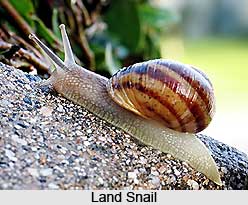 Land Snails are very familiar among the different varieties of Snails. They are identified by the slime-coated, trailing body which comes out of a roundish spiral shell. The animal moves with such a slow pace that in English `a snail`s pace` means very slow indeed. A snail has two pairs of tentacles on its head: a short pair in front and a long pair a little behind. The hinder pair has an eye at the tip of each tentacle. Snails can contract and completely withdraw these tentacles into a hollow in the head. Land Snails are vegetarians (plant-eating). Their mouth is a simple aperture below the head armed with an arched jaw which helps to grip the tender shoots. For grinding the vegetable matter they have a broad radula with rows of uniform squarish teeth. In length this radula does not exceed thrice its breadth. The throat of Land Snails widens inside into a crop which retains a quantity of masticated food before it is passed on to the stomach. Snails are well-known for the havoc they do to gardens.
Land Snails are very familiar among the different varieties of Snails. They are identified by the slime-coated, trailing body which comes out of a roundish spiral shell. The animal moves with such a slow pace that in English `a snail`s pace` means very slow indeed. A snail has two pairs of tentacles on its head: a short pair in front and a long pair a little behind. The hinder pair has an eye at the tip of each tentacle. Snails can contract and completely withdraw these tentacles into a hollow in the head. Land Snails are vegetarians (plant-eating). Their mouth is a simple aperture below the head armed with an arched jaw which helps to grip the tender shoots. For grinding the vegetable matter they have a broad radula with rows of uniform squarish teeth. In length this radula does not exceed thrice its breadth. The throat of Land Snails widens inside into a crop which retains a quantity of masticated food before it is passed on to the stomach. Snails are well-known for the havoc they do to gardens.
Their habits are particularly interesting. As a rule they are moisture-loving animals. In rainy months except when there are heavy downpours, they are found in large numbers moving about over moist stones, moss-covered walls and plants of various kinds. During the hot dry season they close the lid of their shells tight and remain inactive, buried in loose earth or concealed under thick debris. In other words, they estivate. Snails estivate gregariously (many together) and not singly or separately. They are also known for their `homing instinct`. After their search for food or partners they return to the place from which they started.
Land Snails have a life-span of about five years. Their shell is completely developed with lip to years after birth; and their mating capacity commences from the third year. A land snail has both male and female organs which produce sperms and ova at about the same time in separate chambers and these are led by separate ducts to the common genital opening. For fertilization of the ovum, mating of two individuals is necessary. Compared with other molluscs snails lay few eggs. The typical land snail Helix aspersa has been stated to lay forty to one hundred eggs during its life. They are laid in cap-shaped hollows at the roots of grass with a little loose earth spread over them.
The more common species of land snails found in India belong to four genera: Helix, Ariophanta, Xestina and Achatina. Helix has a pale spiral shell growing to four centimetres in diameter and a reddish brown mouth. Ariophanta has a beautiful banded shell measuring six centimetres. Both are very common in western India, Nilgiris, Anaimalais and Nelliampathy Hills and they are eaten by hill tribes. Xestina has a regularly shaped and beautifully banded shell. It is abundant in Tamil Nadu.
Achatina is an African Snail with a tall-spired, large brownish shell 9 cm long and decorated with dark streaks. This snail has now infested all the rainy regions of India, particularly Kerala and West Bengal, and does much damage to vegetation. The eggs of Achatina are 2.5 cm in diameter and yellow in colour. Snails have many natural enemies. Carnivorous ground beetles, frogs, toads, lizards and birds all feed on them. One species Helix vittata - a white-shelled snail - has a bitter taste and is not eaten by birds.



















